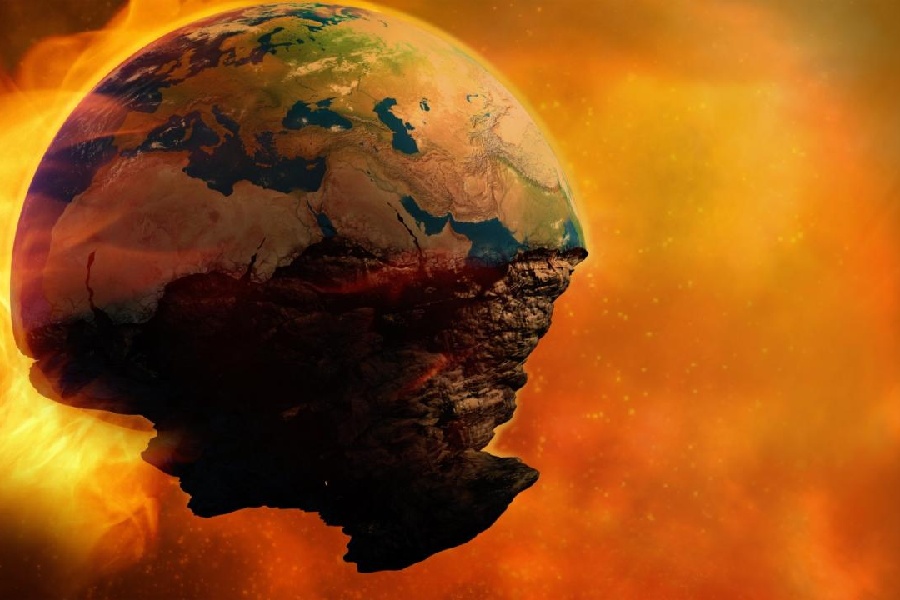The cosmos is filled with countless planets, ranging from hot Jupiter to ice worlds and everything in between. However, the lifespans of planets are finite. Even mighty gas giants and rocky terrestrials eventually meet their demise. But how do planets die? Can a planet explode?
We will explore the different ways that planets can meet their end and delve into the long spans of cosmic time. We’ll also look at how the natural aging process of stars can swallow planets whole or strip them down to their cores. Learn how collisions with other stellar vagabonds can utterly obliterate worlds.
So, read on to discover some of our universe’s most dramatic planet deaths.

How Do Planets Die?
Planets meet their end as stars evolve. When stars age, they expand into red giants, sometimes swallowing up nearby planets or leaving behind remnants known as white dwarfs. Collisions with other celestial bodies can also destroy planets.
Additionally, gravitational interactions cause tidal forces, which can destabilize orbits and eventually lead to destruction. Planets with active geological processes gradually cool down over time. As a result, they lose their atmosphere and magnetic protection, making them uninhabitable.
In the end, planets become lifeless remnants as the universe approaches heat death. So, their destruction is caused by stellar evolution, collisions, and gravitational forces, all influenced by the universe’s fate.
Planetary Catastrophes
There are a few key ways that planets can die catastrophic deaths. As mentioned, one way is through collisions with other massive celestial bodies like planets or large asteroids. But do planets explode?
Yes, these catastrophic impacts can completely shatter worlds, leaving only fragments of the original planets. Even collisions with smaller asteroids can be devastating. If they are big enough, they may cause mass extinctions if they hit planets that harbor life.
Moreover, extreme climate changes, such as runaway greenhouse gas situations, can eventually make planets unsuitable for life. When a planet approaches a black hole closely, its intense gravitational pull can stretch it into oblivion, a process known as spaghettification.
Overall, planets face various threats to their existence over cosmic timescales. These might include catastrophic events like impacts, stellar phenomena, shifts in climate, and gravitational forces.
Atmospheric Erosion and Escape
Planetary atmospheres undergo gradual erosion due to several processes. Faster molecules achieve escape velocity through thermal escape. Solar wind erosion dislodges atmospheric particles. Additionally, chemical reactions transform atmospheric gases into surface compounds.
Impact on habitability
Planetary atmospheres undergo erosion processes over vast periods. Thermal escape enables faster molecules to break free. Alongside this, photoevaporation from UV radiation and solar wind erosion contribute to the gradual loss of atmospheric gases. These processes occur over billions of years, significantly thinning a planet’s atmosphere.
A thinner atmosphere has a reduced capacity to retain heat, impacting the long-term habitability of a planet. Earth’s thick atmosphere is sustained by our global magnetic field, shielding us from solar wind erosion. However, planets like Mars and Mercury have experienced substantial atmospheric loss over time, likely due to the effects of solar winds.
Consequently, planetary atmospheres are in a continual state of gradual escape. This ultimately influences surface conditions’ stability and potential habitability over extensive astronomical time scales.
Black Hole Devouring
Tidal disruption
When planets get too close to black holes, they get destroyed. The strong tidal forces from the black hole can tear the planets apart, turning them into rings of debris. Also, the gravitational pull from the black hole can pull the planets closer, making them spiral inward.
Eventually, they get trapped by the black hole’s intense gravity. As they cross the event horizon, the gravitational forces stretch them into long, thin strands.
Singularity consumption
The journey begins as the planet starts collapsing relentlessly. It shrinks to a minuscule point of boundless density at the singularity of the black hole. All the planet’s mass and energy converge into this tiny spot.
Black holes devour entire planets and obliterate every bit of planetary material. This occurs as objects pass through the event horizon, plunging into a tumultuous gravitational frenzy that leads to infinite destruction. None can withstand the gravitational pull, succumbing to the black hole’s consuming singularity.
Conclusion
How do planets die? We learned that planets can perish in a number of dramatic ways across unfathomable spans of cosmic time. Collisions with stray celestial bodies, extreme climate shifts, and the death of their parent stars are all potential causes of planetary demise.
Additionally, atmospheric erosion and consumption by black holes contribute to this fate. But death and destruction invariably create opportunities for new life and worlds to flourish.
When planets die, their remnants and ejecta can seed nearby space. This ejected material contains chemistry and minerals essential for forming new planets and stars in those regions eventually.
The material that makes up planets gets recycled when they die. It spreads the raw ingredients for new solar systems to coalesce. This occurs across this dynamic, ever-changing universe of ours.
